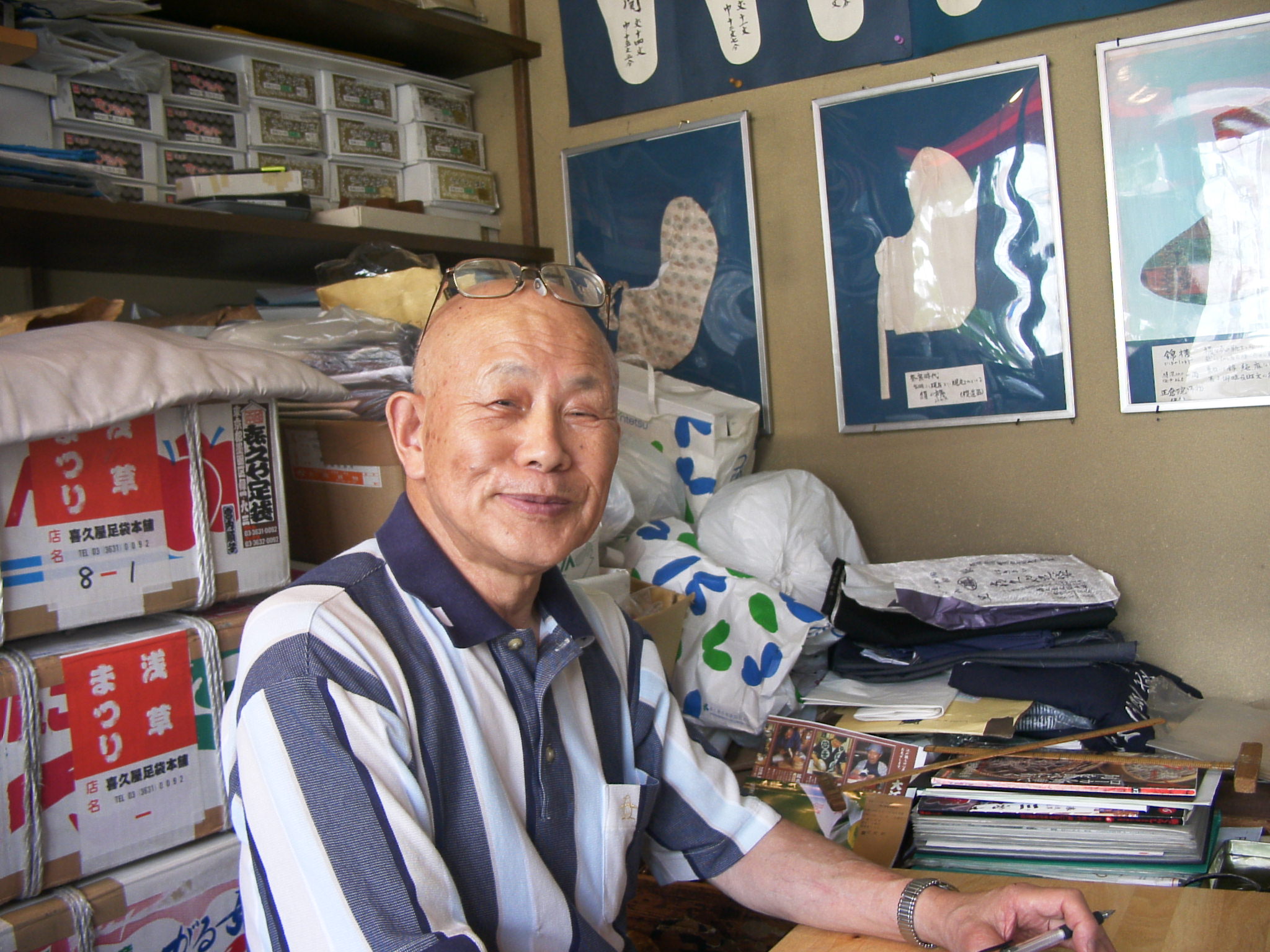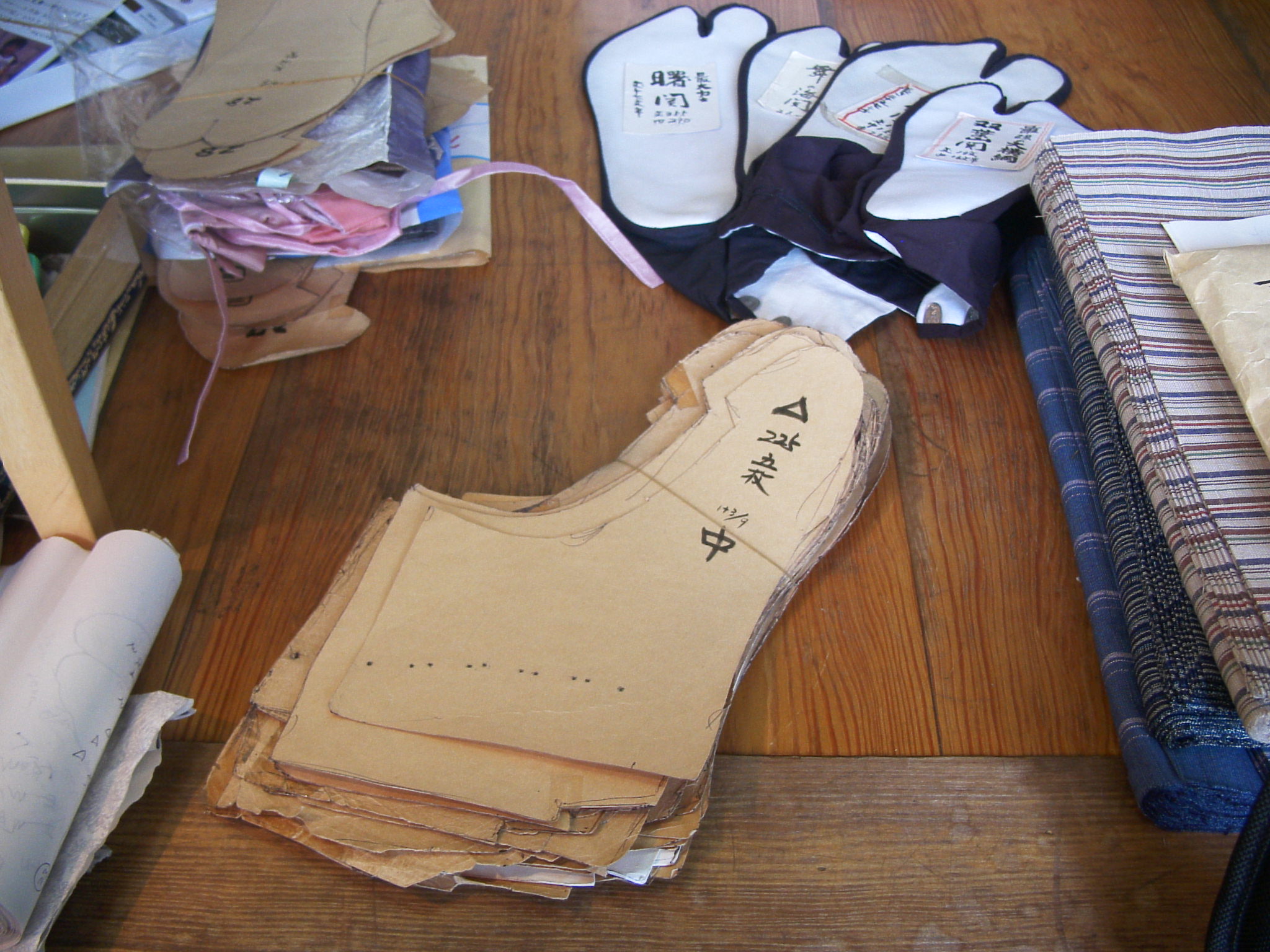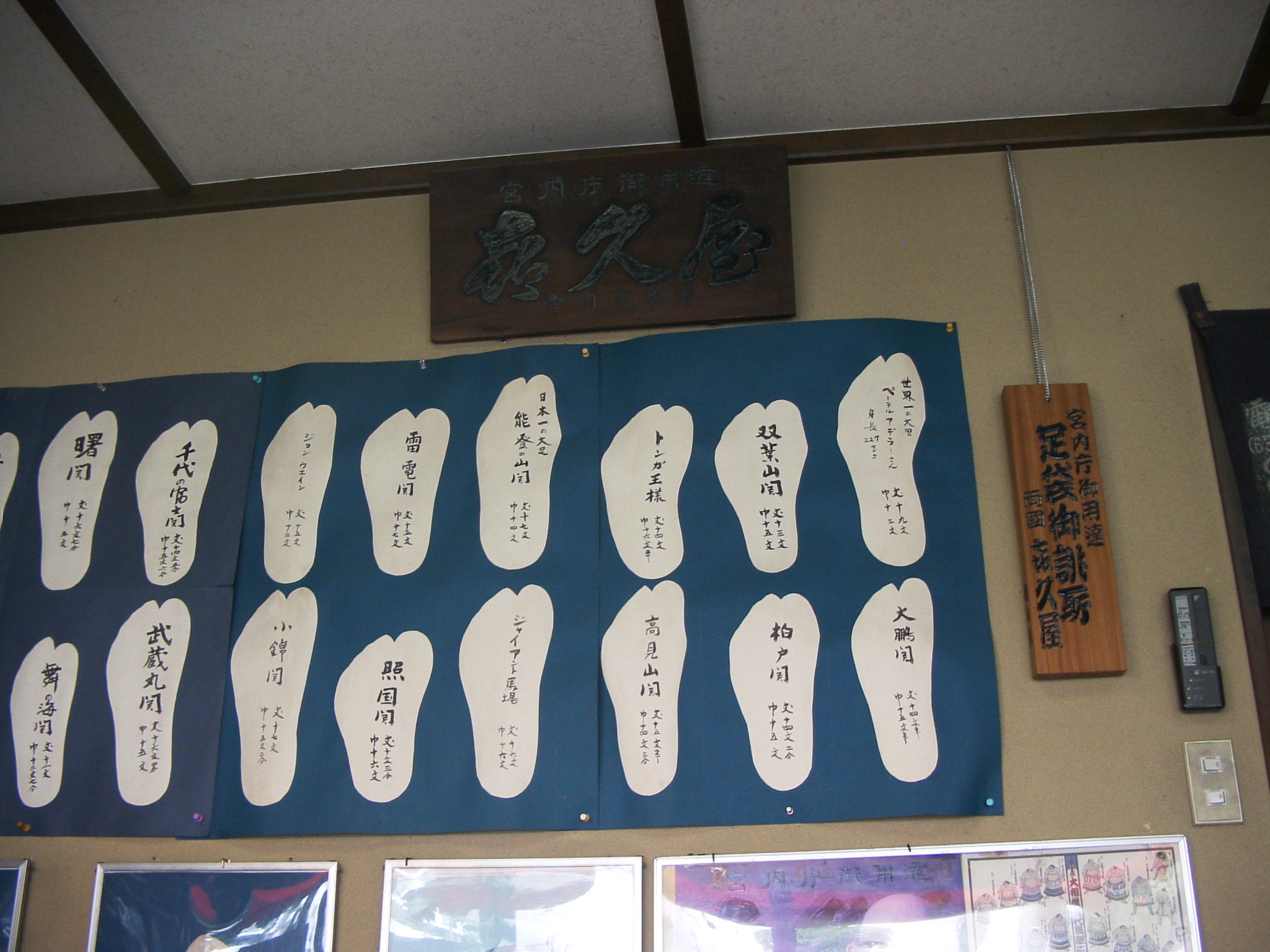*Yedo is old name of Tokyo
**Ryogoku Bashi in Japanese
Currently, the town of Ryogoku exists eastern side of the bridge and it is famous for firework festival in summer and holy place of Sumo wrestling. Few minutes walk from the Ryogoku train station, alongside the Kiyosumi avenue, there is an old shop with a large Japanese signboard mentioning its name "Kikuya Tabi Honpo." In front of its entrance, the shop displays variety of Tabi, traditional footwear, which Japanese wore every day before western style shoes was introduced to this country.
Inside the shop, a gentleman kneeled on his knees, stiffening his back and writing down something. His name is Umeji Miyauchi, 11th master of this Tabi shop, "Kukuya Tabi Honpo," which was established in 1751 and has been serving Tabi to variety of customers throughout its history – ranging from emperor family to Champions of Sumo wrestling, and of course general customers as well.
In most cases, Tabi is made from cotton although there are some unexceptions. Its toe is spread into two: thumb and the other fours. In the past, Japanese wore Tabi every day, however, western style shoes were spread among Japanese abut hundred and several tens of years ago. Although the occasion to wear Tabi is very limited today – probably ordinary Japanese people does not have chance to wear it in their life - those who are working for traditional Japanese business still need it.
"Yes, recently Japanese wears western-style shoes and does not wear Tabi, and our business is shrinking. There are less Tabi manufacturers than ever, and I think today only three are manufacturing Tabi hand-made, throughout Japan, without taking automated factory into account."
According to Miyauchi, Tabi has a few thousands-year history, and it improved during its long history - when we compare Tabi between thousands years ago and today, there are big differences. "Tabi is manufactured under well consideration of human health and functions of human body. I strongly believe Tabi is the best footwear for human being," said Miyauchi.
Miyauchi continued, "May I see your foot?" Then I took of my shoes and throw the leg towards him. After a quick look at my foot, he said, "Size of your foot is 27.5 centimeter long, 11 centimeter wide." After seeing my skeptic face, he said, "Okay, let's measure your feet with scale." He was exactly right. "Basically, Tabi is made-to-order. I need to understand my customer's foot precisely. Sometimes I need to adjust the size by millimeter."
In his notebook, Miyauchi wrote down every single detail of his customer's foot. He also still sticks to hand-made, because it is the only way he can made Tabi to fit to customer.
Miyauchi tries to hear and accept every request from his customers, basically. Customers sometimes ask him to change the size of finger again and again, and Miyauchi accomodates all of them, without asking for extra cost. "I have to look after customers and satisfy them. Since Tabi is made from cotton 100%, its size changes after you wash it. Then customers thinks it does not just fit to their feet - they feel uncomfortable. I have to fix it.
According to Miyauchi, this service has been affecting profitability of Tabi manufacturers. Tabi was all hand made by craftsman and he (usually these Japanese traditional technology is taken over by men) can make no more than one tabi boot a day. Although Miyauchi uses machine today –half of the process is done by machine now- he can only produce 5 or 6 tabi in a day. In such situation, the profitability hugely goes down if he takes every request from customers. "Eventually, it is one of the biggest reason Tabi manufacturers are dropping out of business," Miyauchi said.
Photos by Urban Heritage Chronicle
Umeji Miyauchi, 11th owner of Kikuya Tabi Honpo
Miyauchi records every customer's soleprint in cardboard. He says he can guess customer's sole size in one glance.
Soleprints of celebrities are displayed inside the shop. Sumo wrestlers, actors and actoress - everyone is Kikuya's customer.
Throughout its history, Kikuya had lots of high profile customers, for example, emperors and their families, "Yokozuna" sumo wrstlers such as Raide, Futabayama, and Taiho, and actors of Kabuki, traditional Japanease act. These customers wore Kimono, traditional Japanese dress, on a daily basis. Kimono had to be worn with Tabi," he said.
"The biggest problem is that even sumo wrestlers have less chance today to wear Kimono and Tabi. They put on shoes even when they wear Kimono –basically it violates traditional dress code. Even for them, Tabi is only for special occasion or photo shooting."
Miyauchi, 11th owner, born in 1929, has more than 50 years career as Tabi craftsman. However, he says he still has to learn a lot on Tabi boot production - he is thinking himself as a trainee, still. "It takes at least 20 years to master the technique to produce Tabi boot," he says, "But even if someone can learn the technique for 20 years, he or she cannot work independently if they do not have a good sense of Tabi boot production. In another way, producing good Tabi does not mean producing tabi which satisfies customer."
Miyauchi continues, "One reason for shrinking Tabi market is that we are manufacturing what the market does not need. We are losing jobs because we are selling things nobody needs today. Tabi is a daily necessity in the past, but it is not today. Something might boom at one time, but it becomes obsolete sometime. Making agood product is different from making money."
Ryogoku is a very old place that has been flourishing since Edo era. The most famous piece of the city is the arena for Sumo wrestling – called Ryogoku Kokugikan in Japanese, the holy place of Sumo. The city is also famous for its firework festival which takes place every summer. During these events, the town is filled with people. Both Sumo and firework festival are traditional Japanese events that continues for hundreds of years.
"Because of its historical background, there were many Shinises in this town, but many of them has gone. Even if we are working hard, traditional businesses, "Shinise," are disappearing one by one. The situation does not allow us to survive."
Miyauchi was born and raised in Gunma prefecture as the fifth child of farmer's family. His father worked as a bonesetter as well as farmer. During the second world war, Miyauch was assigned to the air force and went to the frontline. Though he was damaged severely, he survived. After he came back from the war and graduated school, he was adopted to Miyauchi family and took over his stepfather's family business, which was Tabi boot manufacturer.
Miyauchi himself has two daughters. Following Japanese tradition, if he does not have a son, daughter's husband is supposed to take over the family business. However, considering the current environment surrounding Tabi manufacturing business, Miyauchi family decided not to continue the 250-year-old business.
Again, one more Japanese tradition ends and its technique is not taken over.
"My father said that Tabi boot will last as long as tatami mat* can exist," Miyauchi says, "Walking on tatami mat with Ttabi boot represents Japanese tradition, and the two is inextricable each other. However, today Japanese does not use tatami mat – instead they are living on the western-style wooden floor or carbet. Needs for Tabi boot is getting smaller and smaller. Lack of rice straw** and disinterest in Japanese tradition accelerates this trend as well."
*/** Tatami Mats are a Japanese style of floor covering, which is made of rice straw.
"I often discuss with other owners of Japanese traditional businesses, but we agree it's difficult for us to continue our business. We do not use machine, and we make it by hand. As an art, it's good to make it by hand. But as business, it is very tough. I truly want to last this history, but I cannot understand what today's customer wants," said Miyauchi finally.
(This article was written and posted on August 25, 2005)


